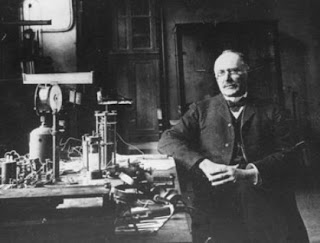Have you ever heard of a device called the Coherer? The Coherer is an early radio signal detector
that was used over 100 years ago. It evolved as a replacement for the Hertz
detector [copper loop conductor with an air gap]. We
know that Hertz was the first to detect electromagnetic waves in 1888 proving
Maxwell’s earlier mathematical predictions. The Coherer, a primitive form of
radio receiver, was a significant participant in the very early days of
wireless.
 |
| Branly in his Lab |
Professor Eduard Branly discovered the Coherer around 1890. His
device transformed the development of wireless technology as Marconi used it in
his first wireless transmission system later in 1896.
Branly was a French Physicist that resumed research on electromagnetic
conductors began by others earlier in the 1880s. His research centered on iron
filings [in powder form]; and their reaction to electromagnetic waves. The
Coherer is essentially a small glass tube with two pieces of metal with wires
attached to each end thus forming electrodes.
The two metal pieces are placed in proximity to each other to form an
air gap where iron or copper filings were positioned.
 |
| Branly's Coherer |
In his early experiments, Branly found that the metal
filings, while lying on a glass plate, changed their resistance when in proximity
to a strong electromagnetic wave [signal oscillations]. He explained this
phenomenon by stating that the filing’s “cohered” [stick together, hold
together]. Branly was also a medical
scientist who researched different theories about how nerves carry messages
from the skin to and from the brain. His
research found that nerves are not continuous fibers but neurons. Neurons are a
bunch of cells gathered closely but are not connected. He equated this neuron
phenomenon to describe the coherer effect.
Branly encapsulated the filings in a glass tube. He attached a battery circuit and a
galvanometer [type of an amp meter] to the coherer; then discharged a Leyden
jar whose electromagnetic wave [oscillations] made the loose metal filings
cohere; that is, form a low resistance circuit, moving and sticking the
filings together to act like a conductor. This completed the circuit allowing the
current to flow [as the galvanometer would indicate]. Disrupting the filings
[separating the loose filings] would stop current flow until another Leyden jar
discharged was conducted for them to cohere again.
This device conceptually opened the door to wireless transmission
as Branly showed that it could detect electromagnetic waves. The coherer is considered
a key element in the development of wireless, and earned Branly a Noble Prize
in 1921. This technology became the standard for early wireless telegraphy
receivers until the “cat whisker” detector was discovered to be a better
detector in 1906.
 |
| Circuit Digram |
In the mid 1890s, the English Physicist Olive Lodge
experimented with Branly’s coherer. Lodge found that it was superior to his detector
device and experimented with it for his wireless transmission system. Lodge was
a noteworthy wireless scientist who conducted many important wireless experiments
prior to Marconi arriving on the scene.
Lodge improved Branly’s device by adding a “tapper” that shook and
loosened the filings after they cohered in between transmissions [clear the
filings when the oscillations ceased]. The Lodge coherer circuit included a bell that
would ring when the filings cohered; stop ringing when the electromagnetic wave
dissipated, then the tapper cleared [shook] the filings apart for the next transmitting/receiving
sequence. Lodge is also responsible for
naming the device the “Coherer”.
Gugliemo Marconi, experimenting with his wireless system,
used the Branly’s coherer and the tapper that Lodge developed to transmit and
receive wireless Morse code. He also improved the device by adding vacuum
chamber to the coherer, thus making it easier for the filings to cohere. Marconi
first successful radiotelegraphy transmission and reception occurred in 1896
[about 40 miles], which resulted in his first radio Patent. He was also responsible for the first transatlantic
radio transmission in 1906.
 |
| Marconi's Coherer |

No comments:
Post a Comment